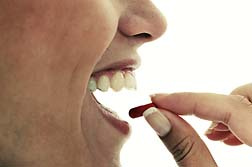 There are a lot of drugs that can cause SJS and TEN (Toxic Epidermal Necrolysis), which are believed to be different degrees of the same illness. "Essentially when a person gets SJS, their skin dies and falls off," says Ainsley, " usually because they took some drug, such as a painkiller, or an antibiotic like my sister took."
There are a lot of drugs that can cause SJS and TEN (Toxic Epidermal Necrolysis), which are believed to be different degrees of the same illness. "Essentially when a person gets SJS, their skin dies and falls off," says Ainsley, " usually because they took some drug, such as a painkiller, or an antibiotic like my sister took."One particular over-the-counter medicine, Children's Motrin has been linked to SJS and several lawsuits have been filed against the maker, Johnson & Johnson. One suit alleges that the company knew for nearly 20 years that Children's Motrin can cause SJS but failed to warn consumers about the danger regarding the drug's over-the-counter labeling. Consequently, a seven-year-old girl suffered a horrific skin reaction and SJS left her blind in both eyes.
Ainsley's sister is hopeful that one day she will be able to see again…
Ainsley has a PhD in Genetics and Molecular Biology; she understands how the immune system functions and how genes can interact with the environment to keep someone healthy or make them sick, but nothing had prepared her for the emotional roller-coaster of her sister's illness. As a scientist, the first thing she did was start researching the literature, and there was no comfort there.
"A lot of antibiotics help a lot of people but for a small percentage of the population they can make you very sick," says Ainsley. "I believe my family is at increased risk for SJS —my grandfather had a similar reaction to an antibiotic 40 years ago and I've read about other instances of two or more members in a single family developing SJS/TEN after taking the same drug. There is good evidence that people with different genetic backgrounds respond differently with different drugs. Certain gene variants have been found to be associated with increased risk for SJS. I absolutely believe there is a genetic component, and I am terrified for my children.
"Certain people--based on the way their immune system genes are configured--are more likely to get SJS TEN when they take certain drugs.
"My sister had just got married; they were looking for a house and planning to start a family. She came down with flu symptoms and her doctor gave her an antibiotic. You wouldn't think this would happen to anyone but she was one of the unlucky ones…
A few days after taking the medication, her throat was inflamed- she couldn't eat or drink, and talking was painful. Her eyes started swelling then the blisters appeared, all over her face, arms and back. She was admitted to the hospital, then the ICU, then the burn unit. Her skin was dying— the blisters were filling with liquid and the top layer was peeling off. She lost all the skin on her face; it was bright red like raw meat; her lips were one big scab and her eyes were so inflamed. SJS affects the respiratory system mucus membranes the same way as the skin. A clot of dead tissue formed in her throat and fell into her lungs and she couldn't breathe.
She was placed on a ventilator, had a tracheotomy and developed pneumonia. She was in a medically induced coma for 6 weeks. While she was in a coma, the doctors sewed her eyes shut to protect them and by the time she came out of it, my sister was incredibly weak. After she started waking up, they had to undo the stitches, check her eyes and sew them up again. She was so frightened and in so much pain.
READ MORE SJS CHILDREN'S MOTRIN LEGAL NEWS
When my sister started to wake up from the coma, the drugs they gave her made her hallucinate. It took her a long time to wake: probably 2 or 3 weeks until she was lucid again. In and out of this reality phase, when I was there or her husband was there, she knew it was real but other times she didn't know what was going on. She was in the hospital for about 6 months.It's almost a year later and she still can't return to work. She has scars all over her body but that is trivial compared to everything else. She has no useful vision in one eye and the other eye developed a corneal perforation so she had a corneal transplant that is healing—she has some vision in that eye. Because of the disease, she is not a good candidate for a transplant in the other eye.
Despite all these horrible things that have happened, my sister is incredibly upbeat; she is a remarkable human being. She is grateful for the vision she does have, she is grateful to be alive. She hopes that she will be able to see again and she still wants to have that baby."




